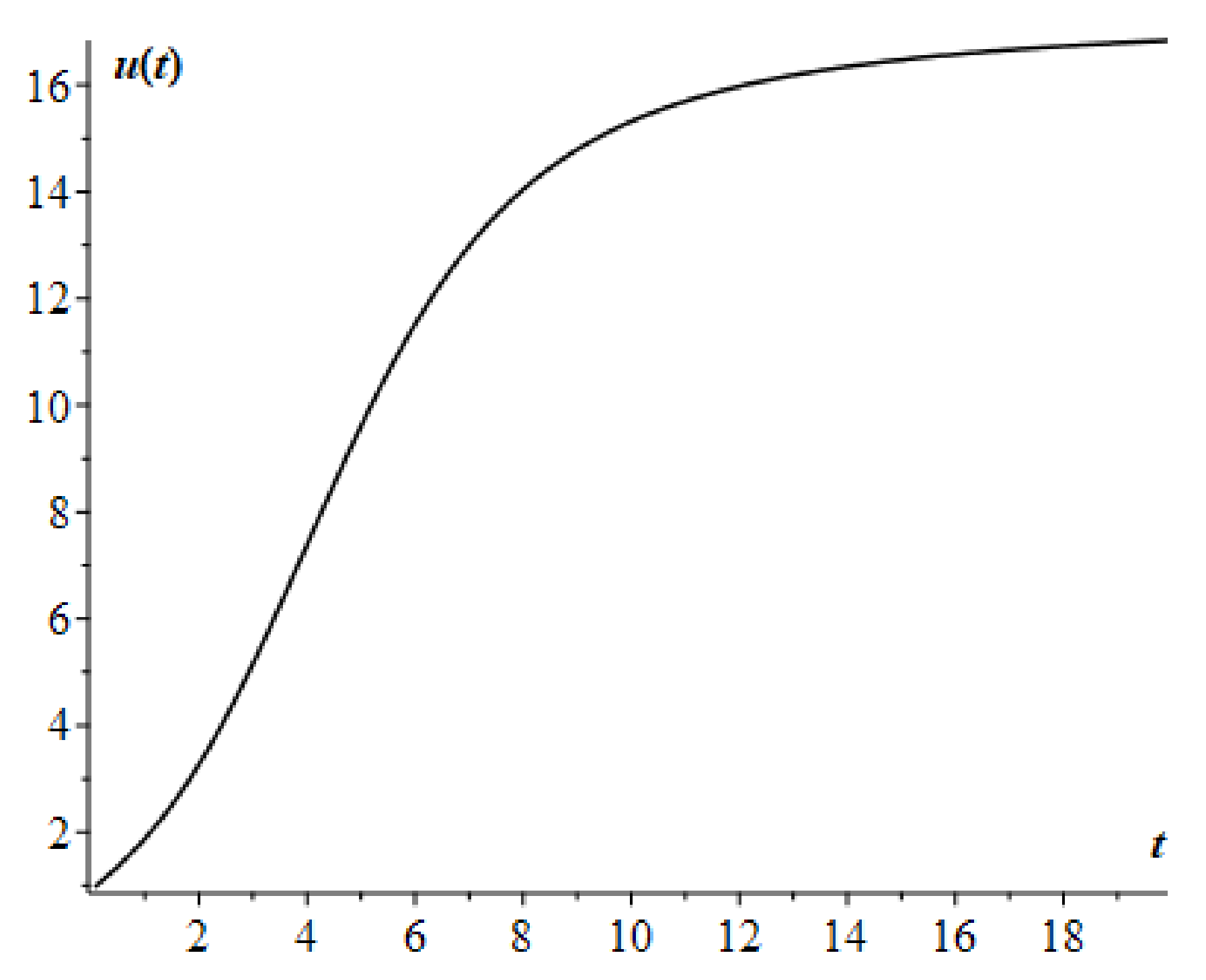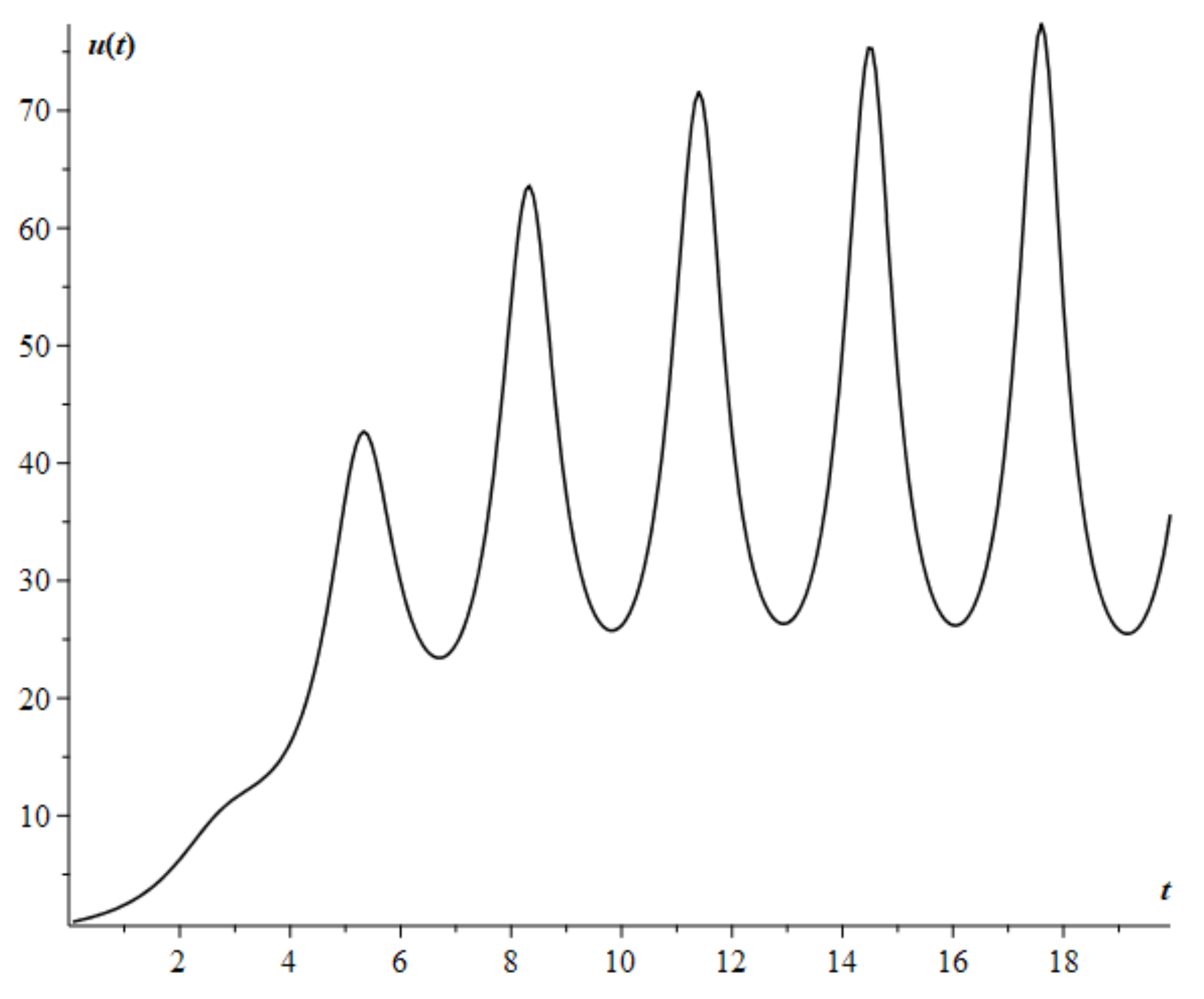Some Aspects of Numerical Analysis for a Model Nonlinear Fractional Variable Order Equation
Abstract
:1. Introduction
2. Preliminary Information
3. Problem Statement and Solution Method
- 1.
- ,
- 2.
- ,
- 3.
- .
4. Numerical Simulation Results
5. Discussion
6. Conclusions
Author Contributions
Funding
Conflicts of Interest
Abbreviations
| FO-VO | Fractional operator of variable order |
| IKIR FE RAS | Institute of Cosmophysical Research and Radio Wave Propagation, |
| Far Eastern Branch of the Russian Academy of Sciences |
References
- Oldham, K.; Spanier, J. The Fractional Calculus. Theory and Applications of Differentiation and Integration to Arbitrary Order; Academic Press: London, UK, 1974; p. 240. [Google Scholar]
- Miller, K.; Ross, B. An Introduction to the Fractional Calculus and Fractional Differntial Equations; A Wiley-Interscience Publication: New York, NY, USA, 1993; p. 384. [Google Scholar]
- Podlubny, I. Fractional Differential Equations: An Introduction to Fractional Derivatives, Fractional Differential Equations to Methods of Their Solution and Some of Their Applications; Academic Press: London, UK, 1998; p. 340. [Google Scholar]
- Kilbas, A.A.; Srivastava, H.M.; Trujillo, J.J. Theory and Applications of Fractional Differential Equations; Elsevier Science: New York, NY, USA, 2006; Volume 204, p. 540. [Google Scholar]
- Petras, I. Fractional-Order Nonlinear Systems. Modeling, Analysis and Simulation; Springer: Berlin/Heidelberg, Germany, 2011; p. 218. [Google Scholar]
- Machado, J.T.; Kiryakova, V.; Mainardi, F. Recent history of fractional calculus. Commun. Nonlinear Sci. Numer. Simul. 2011, 16, 1140–1153. [Google Scholar] [CrossRef] [Green Version]
- Uchaikin, V. Fractional Derivatives for Physicists and Engineers. Volume I Background and Theory; Springer: Berlin/Heidelberg, Germany, 2013; p. 373. [Google Scholar]
- Tarasov, V.E. Review of some promising fractional physical models. Int. J. Mod. Phys. B 2011, 27, 1330005. [Google Scholar] [CrossRef] [Green Version]
- Coimbra, C.F. Mechanics with variable-order differential operators. Annalen der Physik 2003, 12, 692–703. [Google Scholar] [CrossRef]
- Rossikhin, Y.A.; Shitikova, M.V. Application of fractional calculus for dynamic problems of solid mechanics: Novel trends and recent results. Appl. Mech. Rev. 2010, 63, 010801. [Google Scholar] [CrossRef]
- Parovik, R.I. Mathematical models of oscillators with memory. In Oscillators-Recent Developments; Salzenstein, P., Ed.; IntechOpen: London, UK, 2019; pp. 3–21. [Google Scholar]
- Glöckle, W.G.; Nonnenmacher, T.F. A fractional calculus approach to self-similar protein dynamics. Biophys. J. 1995, 68, 46–53. [Google Scholar] [CrossRef] [Green Version]
- Magin, R.L. Fractional calculus in bioengineering, Part 1–3. Crit. Rev. Biomed. Eng. 2004, 32, 1–377. [Google Scholar] [CrossRef] [Green Version]
- Makarov, D.V.; Parovik, R.I. Modeling of economic cycles using the theory of fractional calculus. J. Internet Bank. Commer. 2016, 21, S6. [Google Scholar]
- Tarasov, V.E. Mathematical Economics: Application of Fractional Calculus. Mathematics 2020, 8, 660. [Google Scholar] [CrossRef]
- Ortigueira, M.D.; Machado, J.T. What is a fractional derivative? J. Comput. Phys. 2015, 293, 4–13. [Google Scholar] [CrossRef]
- Samko, S.G.; Ross, B. Integration and differentiation of a variable fractional order. Integral Transforms Spec. Funct. 1993, 1, 277–300. [Google Scholar] [CrossRef]
- Patnaik, S.; Hollkamp, J.P.; Semperlotti, F. Applications of variable-order fractional operators: A review. Proc. R. Soc. A 2020, 476, 20190498. [Google Scholar] [CrossRef] [PubMed] [Green Version]
- Garrappa, R. Numerical Solution of Fractional Differential Equations: A Survey and a Software Tutorial. Mathematics 2018, 6, 16. [Google Scholar] [CrossRef] [Green Version]
- Cai, M.; Li, C. Numerical approaches to fractional integrals and derivatives: A review. Mathematics 2020, 8, 43. [Google Scholar] [CrossRef] [Green Version]
- Sun, H.; Chang, A.; Zhang, Y.; Chen, W. A review on variable-order fractional differential equations: Mathematical foundations, physical models, numerical methods and applications. Fract. Calc. Appl. Anal. 2019, 22, 27–59. [Google Scholar] [CrossRef] [Green Version]
- Valério, D.; Da Costa, J.S. Variable-order fractional derivatives and their numerical approximations. Signal Process. 2011, 91, 470–483. [Google Scholar] [CrossRef]
- Sun, H.; Chen, W.; Chen, Y. Variable-order fractional differential operators in anomalous diffusion modeling. Phys. A Stat. Mech. Appl. 2009, 388, 4586–4592. [Google Scholar] [CrossRef]
- Li, X.; Li, H.; Wu, B. A new numerical method for variable order fractional functional differential equations. Appl. Math. Lett. 2017, 68, 80–86. [Google Scholar] [CrossRef]
- Cao, J.; Qiu, Y. A high order numerical scheme for variable order fractional ordinary differential equation. Appl. Math. Lett. 2016, 61, 88–94. [Google Scholar] [CrossRef]
- Zhou, Y.; Suzuki, J.L.; Zhang, C.; Zayernouri, M. Implicit-explicit time integration of nonlinear fractional differential equations. Appl. Numer. Math. 2020, 156, 555–583. [Google Scholar] [CrossRef]
- Zhao, X.; Sun, Z.Z.; Karniadakis, G.E. Second-order approximations for variable order fractional derivatives: Algorithms and applications. J. Comput. Phys. 2015, 293, 184–200. [Google Scholar] [CrossRef]
- Samko, S.G. Fractional integration and differentiation of variable order. Anal. Math. 1995, 21, 213–236. [Google Scholar] [CrossRef]
- Gerasimov, A. Generalization of linear deformation laws and their application to internal friction problems. AS USSR Appl. Math. Mech. 1948, 12, 529–539. [Google Scholar]
- Caputo, M. Linear Models of Dissipation whose Q is almost Frequency Independent—II. Geophys. J. Int. 1967, 13, 529–539. [Google Scholar] [CrossRef]
- Parovik, R.I. On a finite-difference scheme for an hereditary oscillatory equation. J. Math. Sci. 2021, 253, 547–557. [Google Scholar] [CrossRef]
- Parovik, R.I. Explicit finite-difference scheme for the numerical solution of the model equation of nonlinear hereditary oscillator with variable-order fractional derivatives. Arch. Control Sci. 2016, 26, 429–435. [Google Scholar] [CrossRef] [Green Version]
- Parovik, R. Mathematical modeling of linear fractional oscillators. Mathematics 2020, 8, 1879. [Google Scholar] [CrossRef]
- Lin, Y.; Xu, C. Finite difference/spectral approximations for the time-fractional diffusion equation. J. Comput. Phys. 2007, 225, 1533–1552. [Google Scholar] [CrossRef]
- Tvyordyj, D.A. Hereditary Riccati equation with fractional derivative of variable order. J. Math. Sci. 2021, 253, 564–572. [Google Scholar] [CrossRef]
- Tverdyi, D.; Parovik, R.; Makarov, E.; Firstov, P. Research of the process of radon accumulation in the accumulating chamber taking into account the nonlinearity of its entrance. E3S Web Conf. 2020, 196, 02027. [Google Scholar] [CrossRef]



| i | N | p | ||
|---|---|---|---|---|
| 1 | 10 | 1/10 | 0.039621 | - |
| 2 | 20 | 1/20 | 0.023938 | 0.864994 |
| 3 | 40 | 1/40 | 0.013483 | 0.866691 |
| 4 | 80 | 1/80 | 0.007302 | 0.875344 |
| 5 | 160 | 1/160 | 0.003865 | 0.885493 |
| 6 | 320 | 1/320 | 0.002017 | 0.895208 |
| 7 | 640 | 1/640 | 0.001043 | 0.903937 |
| i | N | p | ||
|---|---|---|---|---|
| 1 | 10 | 1/10 | 0.061331 | - |
| 2 | 20 | 1/20 | 0.040204 | 0.868595 |
| 3 | 40 | 1/40 | 0.023417 | 0.856024 |
| 4 | 80 | 1/80 | 0.012751 | 0.860662 |
| 5 | 160 | 1/160 | 0.006687 | 0.87111 |
| 6 | 320 | 1/320 | 0.003435 | 0.882597 |
| 7 | 640 | 1/640 | 0.001745 | 0.893334 |
Publisher’s Note: MDPI stays neutral with regard to jurisdictional claims in published maps and institutional affiliations. |
© 2021 by the authors. Licensee MDPI, Basel, Switzerland. This article is an open access article distributed under the terms and conditions of the Creative Commons Attribution (CC BY) license (https://creativecommons.org/licenses/by/4.0/).
Share and Cite
Parovik, R.; Tverdyi, D. Some Aspects of Numerical Analysis for a Model Nonlinear Fractional Variable Order Equation. Math. Comput. Appl. 2021, 26, 55. https://doi.org/10.3390/mca26030055
Parovik R, Tverdyi D. Some Aspects of Numerical Analysis for a Model Nonlinear Fractional Variable Order Equation. Mathematical and Computational Applications. 2021; 26(3):55. https://doi.org/10.3390/mca26030055
Chicago/Turabian StyleParovik, Roman, and Dmitriy Tverdyi. 2021. "Some Aspects of Numerical Analysis for a Model Nonlinear Fractional Variable Order Equation" Mathematical and Computational Applications 26, no. 3: 55. https://doi.org/10.3390/mca26030055
APA StyleParovik, R., & Tverdyi, D. (2021). Some Aspects of Numerical Analysis for a Model Nonlinear Fractional Variable Order Equation. Mathematical and Computational Applications, 26(3), 55. https://doi.org/10.3390/mca26030055







